The low nominal interest rate environment is a hotly debated phenomenon among politicians, financial market participants and households. Savers fear the erosion of their retirement savings, while financial supervisors warn of the stability risks caused by declining bank profitability and by the declining profitability of life insurers. Moreover, financial supervisors fear an increase in household debt triggered by a high demand for cheap loans.

Reasons for the Declining Real Interest Rates
IW-Report

The low nominal interest rate environment is a hotly debated phenomenon among politicians, financial market participants and households. Savers fear the erosion of their retirement savings, while financial supervisors warn of the stability risks caused by declining bank profitability and by the declining profitability of life insurers. Moreover, financial supervisors fear an increase in household debt triggered by a high demand for cheap loans.
Most people are interested in whether inflation-adjusted interest rates will rise in the distant future, and, if this is the case, when and by how much they will increase. However, the possibility of increasing real interest rates depends on whether the evolution of real interest rates is due to a rebound of a long cycle or whether it is due to a longer-lasting trend.
Whether the evolution of real interest rates is based on a trend or a cycle cannot be judged by data visualisation. Instead, it needs a more rigorous statistical analysis. Therefore, we first identify the drivers of real interest rates and use a panel data regression model to test whether these drivers are predictive of the evolution of real interest rates. We then use forecasts of the drivers of real interest rates, mostly demographic variables, to identify whether there is a future trend or a mean-reverting behaviour in real interest rates.
The regression model for the real interest rate can be used to calculate the real interest rate that is determined by economic fundamentals. This model-implied interest rate can then be compared to the data in order to detect misalignments that could be caused by accommodative monetary policies or by risk premia. The detection of misalignments is important for our forecasting exercise, because the correction of the misalignment back to a possible trend could be confused with an interest rate cycle.
The analysis indicates that the current low interest rate levels are not solely caused by the accommodative monetary policies of central banks, but are also the outcome of a longer-term downward trend. Although interest rates are currently lower than indicated by macroeconomic factors and, thus, are likely to increase when central banks start to toughen their monetary policies, in the long-run real interest rates will decline predominantly because of demographic factors. This trend will be persistent, because demographic factors seem to be persistent.
For Germany, for example, we find a rebound from currently -0.4 percent to 1.3 percent by 2025 due to the elimination of the misalignment when the ECB starts to normalise its monetary policy. After the normalisation of this interest rate cycle, the negative trend in the real interest rates leads to a decline to a real interest rate of 0.5 percent in 2035 and a real interest rate of 0.0 percent in 2050.
The result of persistently low interest rates has important implications for the long-term investment decisions of savers, life insurers and pension funds.

Markus Demary / Michael Voigtländer: Reasons for the Declining Real Interest Rates
IW-Report


Fin.Connect.NRW-Fachveranstaltung: Banken werden klimaneutral – Welche Konsequenzen ergeben sich für Unternehmen?
Die globalen Megatrends Demografie, Dekarbonisierung, Digitalisierung und De-Globalisierung treffen auf die Industrieregion NRW. Um den Strukturwandel erfolgreich zu bewältigen, müssen die Unternehmen in NRW jährlich 98 Mrd. Euro in Dekarbonisierung und ...
IW
Wie hoch sind die Investitionsbedarfe in die klimaneutrale und digitale Transformation in NRW?
Für die Finanzierung der klimaneutralen und digitalen Transformation müssen in NRW jährlich mindestens 100 Mrd. Euro investiert werden. Dies ergab diese Meta-Analyse der vorhandenen Studien zum Investitionsbedarf in die Digitalisierung. Dabei fallen allein zur ...
IW